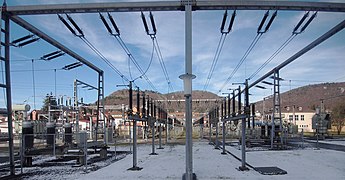Busbar
The busbar is a term from electrical engineering , energy supply and high voltage technology . A busbar is an arrangement of conductors that serve as a central distributor of electrical energy, as all incoming and outgoing lines are connected to the busbars .
Individual busbars have the advantage of being particularly clear. To achieve redundancy in are switching to high voltage multiple busbars normally used. Quadruple busbars are used in very large systems. These multiple busbars are then set up in parallel and can be used optionally. Busbars are often also divided in the longitudinal direction into two or more parts, the so-called blocks or busbar sections. Individual sections of a busbar can thus be operated independently of one another. The use of several busbars offers the possibility to operate quiet and restless loads on different busbars or to activate busbar sections for maintenance work while the loads are switched to the other busbars.
Busbars are made of aluminum or copper and are usually uninsulated, which simplifies the assembly of connection and switching elements. Contact protection, however, must be guaranteed by the switchgear housing. Since the busbars no longer offer contact protection after the housing has been opened, such systems are usually found in main distributions where access is restricted to suitably trained electricians due to further safety measures.
Busbars in high-voltage switchgear
In substations, the cables and transformers are connected to the busbar via so-called switch panels , which are usually constructed in the same way. In high-voltage systems, a bay usually consists of a number of busbar disconnectors (corresponding to the number of parallel busbars), the current and voltage converter or combination converter, the circuit breaker and the line disconnector (also known as feeder disconnector). With the help of multiple busbar disconnectors, the outgoing line can be placed on different busbars.
A distinction can be made between the following field types:
- Outgoing fields: Outgoing or incoming lines are connected to these. A special case is the outgoing panel, in which the transition from a bare busbar to an underground cable takes place.
- Transformer output fields: Outputs to which power transformers are connected.
- Coupling fields: With their help, busbars can be connected to one another lengthways, crossways and diagonally.
- Converter fields: Current or voltage converters are operated in the converter fields, often as so-called combination converters. These busbar fields are therefore used to measure electrical quantities and often also to protect the busbar and the electrical equipment operated on it.
- 110 kV busbars
Other busbar systems
Low voltage sub-distribution
In addition to high-voltage technology, the term busbar is also often used in low-voltage technology for busbar systems in sub-distributions . In the electrical installation of an apartment, a busbar practically corresponds to the connection of the automatic circuit breakers and residual current circuit breakers in the fuse box . There are one to four-pole comb or fork rails for this purpose. The circuit breakers then practically represent the outlets or switchgear panels.
Steam power plant
Steam power plants are partly built as a "busbar system", which means that several boilers feed their steam into a steam busbar from which several turbines can be supplied.
Further use of the term
The line that electrically connects the carriages of a train is known as the train busbar . A 750 km long high-voltage overhead line, built from 1939 to 1941, bears the name Reichssammelschiene .
literature
- René Flosdorff , Günther Hilgarth: Electrical energy distribution . 8th edition. Teubner, 2003, ISBN 3-519-26424-2 .



